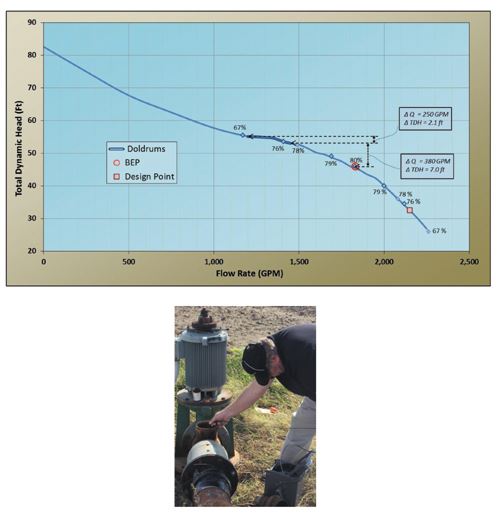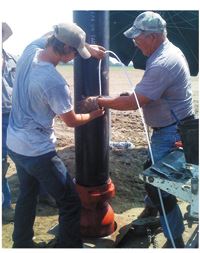|
Choosing The Correct Pump For The Mississippi Alluvial Aquifer: Pump Doldrums
DR. JOE HENGGELER
PORTAGEVILLE, MO.
Irrigators in the Southeast Missouri region (SEMO) are blessed because underneath the land they stride rests a tremendous bounty – the Mississippi Alluvial Aquifer. This awesome groundwater resource is abundant, of good quality, and shallow (thus cheap to capture). I came to Missouri 16 ½ years ago from west Texas, and our water situation here in SEMO is truly a world apart from theirs. The farmers in the St. Lawrence region of Texas have irrigation wells 450 feet deep that today produce 10-25 GPM. They’d plumb 30 to 50 of these wells together with 4-inch pipe and carry on. Back in the day when they were still using furrow irrigation (albeit very short rows, ≈ 700 ft), I use to comment that the output from TWO wells was going into a single water furrow! Working in that area was a primer on efficient irrigation. Thirty years ago we worked together to introduce sub-surface drip irrigation (SDI). In a recent visit back there I learned that 95 percent of their cotton acreage is now SDI. In one of the visits back there I was explaining to the German extraction cotton farmers there about our 2-inch wells that we use to fill up water tanks, and that they could make 100 GPM – and were run with centrifugal pumps. What they would give for a water resource like that!
So getting back to SEMO and its water abundance: in reality there is, however, one problem we do have. Furrow or flood irrigation with electric pumps is problematic. The reason for this is that high- flow low-head (HF-LH) pumps we use can become extremely inefficient with small changes in the water table depth (or even changes in friction loss!). Diesel- and propane-driven pumps don’t have this problem since they can rev up or down following that fluctuating water table. Also, those electric irrigation pumps used on center pivots avoid this problem since the few feet of change in the water table are relatively small in relation to the pump’s total dynamic head (TDH) requirement for pressurizing a pivot. Additionally, HF-LH on electric pumps with variable frequency drives – which are being seen more and more frequently in SEMO these days – are also spared this problem.
Figure 1 is a pump characteristic curve for a typical electric pump used to water furrow-irrigated fields. It is a single stage pump. Its best efficiency point (BEP) lies at 1,830 GPM and 46.0 feet of head; at this point pump efficiency is 80 percent. Note on the pump curve that there is a fairly flat stretch of section to the left of the BEP that I am designating “the doldrums.”

Fig. 1. A characteristic curve for a typical single stage pump used in SEMO for furrow irrigation. The Best Efficiency Point (BEP) is shown at Q = 1,830 GPM and TDH = 46.0 feet. If the pumping water level (PWL) drops 7 more feet, flow rate is reduced by 380 GPM. At that location the operating point of the pump has reached the sensitive flat, doldrums area. Just 2.1 more feet drop in the PWL and Q drops another 250 GPM. The design point should be to the right of the BEP.
Fig. 2. Sounding a well’s Static Water Level by removing an air relief valve and dropping an e-line inside the column pipe while the pump is off.
The Doldrums. Today the term doldrums connotes a period of personal stagnation, or, in popular parlance, “being in a funk”! However, during the nineteenth century when Richard Henry Dana penned Two Years Before the Mast, doldrums was a nautical term referring to places in the seas where at certain times of the year low barometric pressures caused mirror-smooth seas. In the pre-steamer days ships could end up languishing stationary in the doldrums day after day, as water, food supplies, and nerves dwindled away, just as Dana faced sailing around Cape Horn.
Pump curves that are flat, or have segments that are flat, can be pose serious problems in situations where fluctuating water tables exist. As mentioned, the pump in figure 1 has its BEP at 1,830 GPM and 46.0 feet of head. Should the water table drop just 7 feet off this “sweet spot”, its TDH would now be 53 feet (note: water table ↓ = TDH ↑), and flow would decrease to 1,450 GPM (a 21 percent drop). Notice that almost a quarter of the pump’s flow rate has been lost with that first a 7-foot drop in water table. That amount of head loss is not really very much. From 1957 to 2013 there was an average 3.9 feet swing each year in the static water level (SWL) during the 200-day pumping season (April 1 to Oct. 15). These data comes from records from the Missouri Department of Natural Resources’ (MDNR) observation well at Malden, one of the nine monitored observation wells in the Mississippi Alluvial aquifer in SEMO. In some years the Malden spread was almost 8 feet. When you factor in well drawdown on top of this to arrive at the pumping water level (PWL) – the item that pump actually responds to – it is almost for sure that the Malden water table spread will have HF-LH pumps in the region swinging in and out of favorable efficiency ranges. Note that pump efficiency levels are recorded on the pump curve (fig. 1). If that news isn’t gloomy enough, consider this: Malden’s 3.9 foot swing is on the smaller side. The average swing for the nine observation wells is 7.5 feet; Quilin has an 18.1 foot seasonal swing!
Unfortunately, things could get worse. With the TDH value of this pump now at 53.0 feet (remember we have just gone 7 feet away from the BEP where the TDH was at 46.0 ft), the pump is operating at the cusp of the doldrums region where things go real bad, real fast. Now with just 25 inches of additional head loss at this point, 17 percent of the present 1,450 GPM vanishes, and we are down to a mere 1,200 GPM!
The debilitating loss of water caused by the increase in TDH doesn’t come only from a dropping water table; at the flow rates we are talking about, adding an 8-inch surge flow valve inline would have engendered the same flow loss. These water table swings are inevitable. The HF-LH irrigator fights back by, first, gaining knowledge of the SWL and PWL at his well and, secondly, using this knowledge to choose the correct pump.
How to Manage. Having a resource like the Mississippi Alluvial Aquifer at our disposal is a blessing. However, we still have problems irrigating out of this shallow aquifer if we use regular electric pumps for furrow irrigation. So how do we get around the problems for the HF-LH systems?
1. Install air lines in your wells. Air lines of themselves won’t solve the problem, but they do give you insight into what is occurring. These homemade devices cost just about $35 to fabricate. They need to be put in when a new pump is being installed (fig. 2). An air line is to an irrigator what a stethoscope is to a doctor. You do not know if there is a problem nor its extent unless you can assess the situation. For information on air lines: http://crops.missouri.edu/irrigation/
2. Install a variable frequency drive unit.
3. Study your pump curve to see if it has a doldrums area that should be avoided.
4. Choose a location on the right side of the BEP as your design point (c.f., Fig. 1). In this case, if increased head occurs it will shove the operating point to regions of higher efficiencies, not lower efficiencies.
5. If you know that you will be replacing the pump in a well, begin collecting actual information on Q and PWL while the old unit is still in place. a. It would be wise to purchase a flow meter. Install it and begin collecting this information. The investment in the meter would yield dividends in the future with lower energy costs. Based on $0.17/KWH and 80 acres with 12 inches applied, there would be a $200 per year savings on energy costs had the irrigator chosen a pump based on the design point versus one based on the BEP (c.f., fig. 1). At those rates the investment in the water meter would soon be recaptured.
6. While your well is being developed insist that the drillers collect both Q and PWL data. This will go a long way in getting the right pump for you.
Unfortunately, when site-specific data is unavailable, irrigation companies are, to a degree, blindfolded in getting the best HF-LH for their electricity user customers. This is due to the fact that predicting exactly where the PWL will be in a new well is difficult – and also it’s a moving target, with in-season changes, drought period changes, and even changes in commodity prices affecting when the aquifer’s SWL begins to move south. We have seen where being off by just inches on the TDH value can lead to experiencing big water and efficiency losses.
Irrigation professionals today are better equipped in estimating a reasonable TDH value to couple with the GPM amount the farmer is shooting for. This is in great part due to the MDNR’s network of nine observation wells in the Bootheel. Triangulation of the water depth at any three of these wells would be a good estimator of the SWL in your well, or while it’s off you could sound it through some sort of access port (figure 3). Knowing what the range of expected in-season SWL values will be is an excellent starting off point in determining what TDH value is needed. Also, friction loss, which accounts for about 5 percent of TDH, can be precisely accounted for. However, now comes a big unknown: what will be the drawdown for the Q being sought?

Fig. 3. Sounding a well’s Static Water Level by removing an air relief valve and dropping e-line into the column pipe while the pump is off.
As an estimate use 1 foot of drawdown for every 100 GPM desired. Thus if you are planning on 2,000 GPM figure 20 feet of drawdown; if 3,000 GPM is your goal, plan on 30 feet. Add these to your July SWL and throw in a bit for friction losses. While these are good estimating tools, nothing beats having an air line in place. A smoke detector in every home, an air line in every well!∆
DR. JOE HENGGELER: Irrigation Specialist, Commercial Agricultural Program, University of Missouri Delta Center
|
|